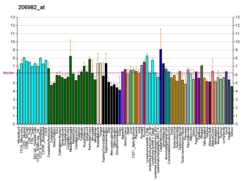Crystallin, beta A1
Beta-crystallin A3 is a protein that in humans is encoded by the CRYBA1 gene.[5][6][7]
Crystallins are separated into two classes: taxon-specific, or enzyme, and ubiquitous. The latter class constitutes the major proteins of vertebrate eye lens and maintains the transparency and refractive index of the lens. Since lens central fiber cells lose their nuclei during development, these crystallins are made and then retained throughout life, making them extremely stable proteins. Mammalian lens crystallins are divided into alpha, beta, and gamma families; beta and gamma crystallins are also considered as a superfamily. Alpha and beta families are further divided into acidic and basic groups. Seven protein regions exist in crystallins: four homologous motifs, a connecting peptide, and N- and C-terminal extensions. Beta-crystallins, the most heterogeneous, differ by the presence of the C-terminal extension (present in the basic group, none in the acidic group). Beta-crystallins form aggregates of different sizes and are able to self-associate to form dimers or to form heterodimers with other beta-crystallins. This gene, a beta acidic group member, encodes two proteins (crystallin, beta A3 and crystallin, beta A1) from a single mRNA, the latter protein is 17 aa shorter than crystallin, beta A3 and is generated by use of an alternate translation initiation site. Deletion of exons 3 and 4 causes the autosomal dominant disease 'zonular cataract with sutural opacities'.[7]
References
- 1 2 3 GRCh38: Ensembl release 89: ENSG00000108255 - Ensembl, May 2017
- 1 2 3 GRCm38: Ensembl release 89: ENSMUSG00000000724 - Ensembl, May 2017
- ↑ "Human PubMed Reference:".
- ↑ "Mouse PubMed Reference:".
- ↑ Hogg D, Tsui LC, Gorin M, Breitman ML (Oct 1986). "Characterization of the human beta-crystallin gene Hu beta A3/A1 reveals ancestral relationships among the beta gamma-crystallin superfamily". J Biol Chem. 261 (26): 12420–7. PMID 3745196.
- ↑ Sparkes RS, Mohandas T, Heinzmann C, Gorin MB, Zollman S, Horwitz J (Nov 1986). "Assignment of a human beta-crystallin gene to 17cen-q23". Hum Genet. 74 (2): 133–6. doi:10.1007/BF00282076. PMID 3770741.
- 1 2 "Entrez Gene: CRYBA1 crystallin, beta A1".
Further reading
- Hulsebos TJ, Bijlsma EK, Geurts van Kessel AH, et al. (1991). "Direct assignment of the human beta B2 and beta B3 crystallin genes to 22q11.2----q12: markers for neurofibromatosis 2". Cytogenet. Cell Genet. 56 (3–4): 171–5. doi:10.1159/000133080. PMID 2055112.
- Basti S, Hejtmancik JF, Padma T, et al. (1996). "Autosomal dominant zonular cataract with sutural opacities in a four-generation family". Am. J. Ophthalmol. 121 (2): 162–8. doi:10.1016/s0002-9394(14)70580-x. PMID 8623885.
- Werten PJ, Carver JA, Jaenicke R, de Jong WW (1997). "The elusive role of the N-terminal extension of beta A3- and beta A1-crystallin". Protein Eng. 9 (11): 1021–8. doi:10.1093/protein/9.11.1021. PMID 8961355.
- Lampi KJ, Ma Z, Shih M, et al. (1997). "Sequence analysis of betaA3, betaB3, and betaA4 crystallins completes the identification of the major proteins in young human lens". J. Biol. Chem. 272 (4): 2268–75. doi:10.1074/jbc.272.4.2268. PMID 8999933.
- Kannabiran C, Rogan PK, Olmos L, et al. (1998). "Autosomal dominant zonular cataract with sutural opacities is associated with a splice mutation in the betaA3/A1-crystallin gene". Mol. Vis. 4: 21. PMID 9788845.
- Srivastava OP, Srivastava K (1999). "Characterization of a sodium deoxycholate-activatable proteinase activity associated with betaA3/A1-crystallin of human lenses". Biochim. Biophys. Acta. 1434 (2): 331–46. doi:10.1016/s0167-4838(99)00183-1. PMID 10525151.
- Graw J, Jung M, Löster J, et al. (2000). "Mutation in the betaA3/A1-crystallin encoding gene Cryba1 causes a dominant cataract in the mouse". Genomics. 62 (1): 67–73. doi:10.1006/geno.1999.5974. PMID 10585769.
- Vanita, Sarhadi V; Reis A; et al. (2001). "A unique form of autosomal dominant cataract explained by gene conversion between beta-crystallin B2 and its pseudogene". J. Med. Genet. 38 (6): 392–6. doi:10.1136/jmg.38.6.392. PMC 1734905. PMID 11424921.
- MacCoss MJ, McDonald WH, Saraf A, et al. (2002). "Shotgun identification of protein modifications from protein complexes and lens tissue". Proc. Natl. Acad. Sci. U.S.A. 99 (12): 7900–5. doi:10.1073/pnas.122231399. PMC 122992. PMID 12060738.
- Strausberg RL, Feingold EA, Grouse LH, et al. (2003). "Generation and initial analysis of more than 15,000 full-length human and mouse cDNA sequences". Proc. Natl. Acad. Sci. U.S.A. 99 (26): 16899–903. doi:10.1073/pnas.242603899. PMC 139241. PMID 12477932.
- Qi Y, Jia H, Huang S, et al. (2004). "A deletion mutation in the betaA1/A3 crystallin gene ( CRYBA1/A3) is associated with autosomal dominant congenital nuclear cataract in a Chinese family". Hum. Genet. 114 (2): 192–7. doi:10.1007/s00439-003-1049-7. PMID 14598164.
- Reddy MA, Bateman OA, Chakarova C, et al. (2004). "Characterization of the G91del CRYBA1/3-crystallin protein: a cause of human inherited cataract". Hum. Mol. Genet. 13 (9): 945–53. doi:10.1093/hmg/ddh110. PMID 15016766.
- Ferrini W, Schorderet DF, Othenin-Girard P, et al. (2004). "CRYBA3/A1 gene mutation associated with suture-sparing autosomal dominant congenital nuclear cataract: a novel phenotype". Invest. Ophthalmol. Vis. Sci. 45 (5): 1436–41. doi:10.1167/iovs.03-0760. PMID 15111599.
- Gerhard DS, Wagner L, Feingold EA, et al. (2004). "The status, quality, and expansion of the NIH full-length cDNA project: the Mammalian Gene Collection (MGC)". Genome Res. 14 (10B): 2121–7. doi:10.1101/gr.2596504. PMC 528928. PMID 15489334.
- Lapko VN, Cerny RL, Smith DL, Smith JB (2005). "Modifications of human betaA1/betaA3-crystallins include S-methylation, glutathiolation, and truncation". Protein Sci. 14 (1): 45–54. doi:10.1110/ps.04738505. PMC 2253330. PMID 15576560.
- Takata T, Oxford JT, Brandon TR, Lampi KJ (2007). "Deamidation alters the structure and decreases the stability of human lens betaA3-crystallin". Biochemistry. 46 (30): 8861–71. doi:10.1021/bi700487q. PMC 2597435. PMID 17616172.
- Lu S, Zhao C, Jiao H, et al. (2007). "Two Chinese families with pulverulent congenital cataracts and deltaG91 CRYBA1 mutations". Mol. Vis. 13: 1154–60. PMID 17653060.




